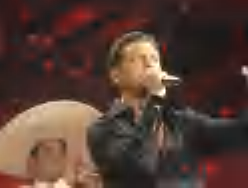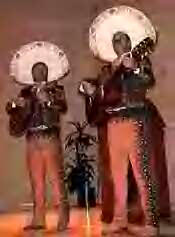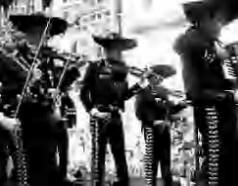The mariachi tradition has been extensively influenced from Mexico to the United States, Argentina and to other countries, particularly Colombia. Colombian music is highly influenced by popular Mexican mariachi traditions.
The American composer Jeff Nevin has composed a Concerto for Mariachi and Orchestra, which was premiered by the La Jolla Symphony.
Mariachi Vargas de Tecalitlan is one of the oldest mariachi's in mexico's history. Their sones are what makes them unique.
Luis Miguel.
 llll
llll
Mariachi music gets its characteristic sound from the various Jalisco sons (sones jaliscienses) that formed the basis of the early ensembles repertoire. There are two principal catgories of son in Jalisco: those from the South (sones del sur) and those from the North (sones alteñeos). The sones in the South were influenced by African music brought to the coastal regions by slaves who worked sugar plantations there during colonial times, and by the folk traditions of the high plateaus of the tierra caliente. The sones in the North were influenced by the criollo ensembles popular on haciendas. The mixture of the rhythmic complexity of music from the south and the clog-dance driven structure of the music from the north came together to form a village son jalisciense in the larger towns of central Jalisco, and from that the mariachi sound emerged.
Traditional mariachi music is made up of a combination of song-specific melodies and common tropes (introductions, bridges, and codas). The presence of the tropes allows for an ensemble to play a piece without everyone in the ensemble needing to know it well. Much of the ensemble can play basic obligato parts for much of any given piece and still demonstrate virtuosity in the trope figures.
Mariachi violin music is typically played in fixed positions, and the positions are generally limited to I and III. Most mariachi pieces are made up of collections of smaller pieces, and with respect to the violin, it's common to include some in the first and some in the fifth position. For example in the famous Jarabe Tapatío, the first two sections are in first position, followed by two section in third with a short bridge in first, after which the piece finishes in first. The nearly exclusive use of these two relatively stable positions facilitates playing together in tune.
The national drink of Mexico, Tequila, is produced in the Jalisco town of the same name. The Jarabe Tapatio, (Mexican Hat Dance), is the national folk dance, but named for Guadalajara, the capitol of Jalisco. The Mariachi, musical groups that symbolize Mexico, began in Cocula, Jalisco. The national sport of Mexico is the Charreria, (rodeo) popularized by Charros (horsemen) from vast Jalisco ranches.
The most recognized symbol of Mexico is also associated with each of these great traditions of Jalisco. It is the elegant snugly tailored black suit and vest, extravagantly trimmed with embroidery and silver buttons; worn with a soft tie, revolver and wide brimmed sombrero, the Traje de Charro.
The musicians’ background was from working-class and rural towns, so the first Mariachis dressed in a peasants attire, which included large straw sombreros with a chin strap, a hat band, red sarape or black wool blanket over the shoulder, long straight-cut muslin pants, a cotton shirt of the same material called manta, a red sash around the waist, and simple huaraches (sandals). The black wool blanket and the red sash are the only added item. The traje de charro evokes gentleman landowners and talented cowboys (charros) of the time of Maximillian's rule.
Mexico's history, complexity and contrasts are vividly illustrated in the tradition of this suit that pays homage to and demands the respect of the men who wear it. This suit reflects the nation's pride, passion and respect for heritage, custom and tradition.
While the same style suit is sold to Charros, Mariachi groups, politicians, folkloric dance troupes, bridegrooms and popular singers, it is only truly a Traje de Charro (Charro suit) when worn by members of the prestigious Charro organizations. Stores specializing in clothing for the horseman advertise the same outfit as the Traje de Jalisco, the Traje de Charro and the Traje de Mariachi. The suits may look identical, and even merchants may see it as the same suit. But, the men who wear the suit know the differences that have caused a 70-year bitter controversy over the wearing of Charro clothing by non-Charros.
The National Federation of Charros, and The National Association of Charros were formed in the early 1900's to maintain the authenticity of the clothing of the Charro, to license Charros and supervise the events included in competitions. These organizations seek to protect the historic tradition and patriotic history by enforcing dress and behavior codes. When Mariachis and performers vary the color, design and accessories of the Charro, they challenge over 400 years of custom. The Charros have complained that others are wearing the Traje de Charro casually and as "totally deformed, outlandish and grotesque costumes."
During WWII, President Manuel Avila Camacho declared the Charros the first reserve of the Ejercito Mexicano (Mexican Army) and charged them to continue their training, customs and tradition in order to defend their country if necessary. This honor was conferred on the Charros along with the right to carry a side arm to commemorate their valiant efforts to protect Mexico in several hundred years of battles and revolutions.
During Colonial times and for several more centuries, the ranch workers and musicians wore white cotton trousers and shirts with huaraches (woven sandals) and big woven hats with pointed crowns.
Fine fabrics, dyes and buttons were reserved by law for the use of the Spanish landowners who wore riding costumes from the Salamanca, Navarra and Andalucia regions of Spain. Their sumptuously elegant short, tight pants and jackets were adorned with silver ornaments and worn with richly embroidered shirts; boots and flat-brimmed hats.
In 1619 the laws forbidding Mestizos and Indios to ride horses under penalty of death were lifted and workers eventually also gained the right to wear better fabrics and to adapt their clothing to be practical for riding.
The rancheros first developed suits using available coarse fabrics, making the pant legs wider and adjustable with pleats on the sides. They buttoned on chivarras (goat hide chaps); and developed leather tapabalazos (bullet protection for chest and legs) to use in battle). For weekends and competitions, they decorated their plain clothing by appliquéing suede designs and adding embroidery and leather buttons to shirts, pants and jackets.
How typical of the ambivalence of Mexico that the Emperor of the country was the greatest promoter of the Traje de Charro and a favorite of the country's horsemen because of his riding ability; but became so unpopular politically due to his association with the French that he was executed by firing squad. The Archduke Maximilian of Hapsburg frequently wore the elegant black Charro suit with silver buttons and was the first to use the outfit in place of a tuxedo at formal events of state.
Today's connection between the clothing of the Charro and the Mariachi didn't begin until the early 1900's when Miguel Lerdo de Tejada, dressed his ballroom orchestra as Charros in order to Mexicanize their image. Groups playing Mariachi music wore the popular style of the times until the 1930's when they adopted the Traje de Charro and groups began dressing alike.
Silvestre Vargas, founder of the world-famous Mariachi group from Tecatitlan frequently spoke of the thrill he experienced when he could afford to dress his group in inexpensive simple Charro-like suits with cheap brass decorations, wide brimmed hats and boots.
The Mariachi continually varied the outfit, until the Charros exploded in a fit anger at the misuse of the national costume of Mexico. They argued that the Charro suit belonged to the horsemen of the country, and that musicians and others should be forbidden to wear it. From this attitude has evolved a saying among the Charros. A Charro whose outfit does not comply with the rules of the organization, is said to be "wearing only the suit of the Mariachi, not that of the Charro."
Charros are extremely offended if mistaken for Mariachis, although today's musicians follow more standards and rules to properly represent the suit. While they know it is not acceptable to ignore the Charro's regulations, some musicians admit to wearing an ensemble that is a little "different" than the Charro.
Mariachis often wear vividly colored, custom embroidered, permanently tied monos, the Charro is required to tie his corbata from a silk rectangle of specific dimensions. A Charro is excluded from competition if he does not wear a precisely cut and styled shirt with leather, wood or silver buttons on the cuff-less sleeves. Mariachis often wear "civil" dress shirts.
The huge-brimmed sombrero of Mariachi and the Charro is made from several materials in a variety of price ranges. The lower priced hats range from the touristy flat-brimmed cardboard covered with garishly embroidered cloth to woven palm covered with gamuza (suede) or fabric and decorated. The best hats are made from wool, or the most expensive rabbit hair felt.
The styles worn by the Charro are the Pachuca and the San Luis Moderado. Both feature the back brim rolled up and four deep dents in the tall crown to protect the rider's head in a fall. The forrador (border) at the edge of the brim and a tall design around the crown are embroidered or appliquéd in suede. The galones (silver disks) often are placed on the sides of the crown.
A third style of sombrero, generally worn by the Mariachi, is called the Cocula. The brim is lifted in front and rolled high in the back. Only two dents are pinched into the crown, as the musician does not depend on protection from falls, sun or rain.
The Traje de Charro varies according to the activities of the man who wears it. Always included are the sombrero, Charro-cut pants and shirt, leather belt with holster and revolver and ankle high boots with an elevated riding heel and spurs. The fabrics, colors, decorations, and use of optional jacket and vest vary with the formality of the suit and of the occasion.
The Faena or Corporal is a simpler outfit for work or competition. It includes pants with front pockets, and a Charro shirt. Boots, belt and holster and straw or felt hat complete the work suit, although a jacket or vest may be added. This more durable outfit is made from sturdy fabrics like twill, denim, cotton, wool, leather and suede. The shirt is always worn closed at the neck and must include a tie if worn in competition. Pants have three buttons of bone, wood or horn, often toggle shaped on each leg, and on the cuffless shirtsleeves.
Embroidery or appliquéd suede called Greca may be added to the shirt and pants. Another popular form of inexpensive decoration is forming scrolling designs in sutach (narrow trim) on sleeves, sides of pants, shirt or jacket back. These more ornamental suits are often used for first communions, by beginner Mariachi groups, and for fiestas or folkloric dance groups. The striking Cachiruleado Suit is richly appliquéd with faux or real suede on the sleeves, lapels, and sides of pant and is often worn by performers.
The Media Gala suit is made from dark colors of wool, suede or gabardine, and is worn with jacket and optional vest. With it are boots in brown, tan, gray or black leather with matching belts and holsters, and hats. Mariachi groups and other entertainers, who choose suits in a variety of colors and with more extravagant embroidery, and Greca designs, wear the Media Gala, as the embroidery replaces the more expensive buttons down the length of the legs.
The national costume of Mexico is the Gran Gala Traje de Charro, which is used for parades, meetings, performances or church services. The dark suit is worn with a full set of silver or gold Gala or botonadura (buttons connected with chains down the outside of the leg), a set of brooches closing the front of the jacket, tie, black boots, and white or gray sombrero frequently embroidered in silver or gold metallic designs.
The style of the Gran Gala and the extremely formal Traje de Etiqueta or Ceremonia is the same and both feature the full set of leg buttons. The only difference between the two suits is the quality of the fabrics and accessories. When wearing the Etiqueta or Ceremonia, a silver plated revolver, black patent leather boots, belt and holster, and tie in black, white or red silk are required. It is used as a tuxedo, for weddings, funerals or other very formal occasions. Riding a horse wearing formal attire is not permitted, unless a short procession to or from the church is part of a wedding or funeral.
The horseman, the musician and the dancer wear the Mexican national costume today with equal pride. The Traje de Charro is a tribute to the Mexican male, his taming of the horse and of the land. It celebrates his ability to survive conquerors, invasions, revolutions and change. It recalls his patriotism and strength when protecting and defending his country and his home. It commemorates the artisans of the country who combine their skills and original designs to produce in each suit a work of art. It recognizes above all the inspiration, great professionalism and respect for tradition the entire country has for a richly revered symbol of Mexican strength and masculinity.
Current mariachi instrumentation includes a guitarrón, a vihuela, a guitar, violins, and trumpets. Some groups might use a guitarra de golpe, a mariachi harp or even a flute. From the 70's some singers have occasionally added other instruments as accordion, organ, keyboard, harmonica, saxophone and even drums, although they were considered additions, never part of the mariachi instrumentation itself. During the last years ranchera singers as Alejandro Fernandez, Pablo Montero and Pepe Aguilar have made fusions of mariachi with orchestra and drums/percussions giving birth to a mariachi/pop ballads crossover style.
The Mariachi music became the symbol of the Mexican Revolution (1910-1920) because it represented the Mexican’s national spirit or the Spanish-indigenous blood of Mexican ethnicity. The Mariachi has different forms of music such as son, cancion ranchera, bolero ranchero, huapango and polka. As well, Mariachi is poetic using the copla and seguidilla forms. Mariachi music is played for serenades, baptism, birthdays, quinceañeras, weddings, Mother’s Days, funerals, conventions, store openings, company parties, civic celebrations, political campaigns, Mass, or in restaurants, bars, theaters, radio and television shows. This music is so anchored in Mexico’s history that it is found in all types of celebration. Over time, this popularity has divided Mariachi music into two types: the authentic folk mariachi which consists of only string instruments and the commercial urban Mariachi which has changed the original music the mariachis played. The music was at first introduced by men; today, women mariachis have been on the rise. This came with the popularity of Mariachi music among the Mexican community living in the United States, which allowed women to be part of this cultural phenomenon. Still, the presence of women in Mariachi bands within Mexico's borders remains scarce.



 llll
llll

